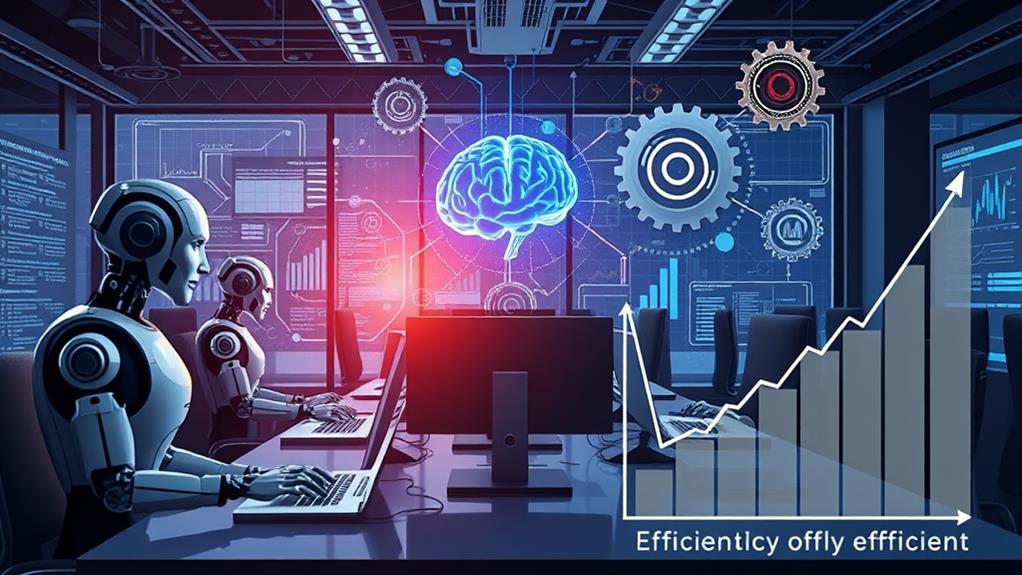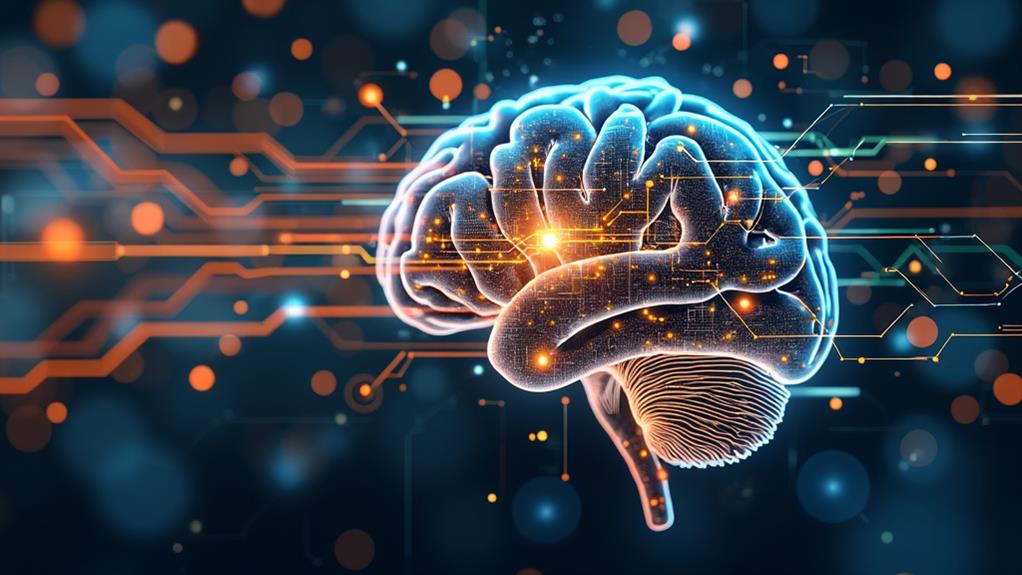Natural Language Processing (NLP) supercharges automation by transforming chaotic, unstructured data into neat, actionable insights faster than you can say “efficiency.” Imagine chatbots that never sleep and email sorting that doesn’t need coffee breaks. NLP not only cuts down on mind-numbing repetitive tasks but also powers smarter decision-making with bias-free data interpretation. From parsing texts with tokenization to emotional check-ins via sentiment analysis, NLP’s toolbox is full of tricks to keep operations smooth. Combining NLP with AI, think smarter automation that’s always learning and improving. Stay tuned, the modern marvels of NLP will keep you riveted!
Table of Contents
Key Takeaways
- NLP processes unstructured data swiftly, enhancing operational efficiency.
- Intelligent chatbots powered by NLP provide 24/7 customer support.
- NLP automates repetitive tasks like email classification and sentiment analysis.
- Data-driven decision-making is improved by extracting insights from customer feedback.
- NLP reduces human biases, ensuring more accurate data interpretation.
Benefits of NLP in Automation

Leveraging Natural Language Processing (NLP) in automation presents numerous advantages that streamline and enhance operational efficiency. Imagine a world where machines can effortlessly sift through mountains of unstructured data, making sense of it all in mere moments—sounds like magic, right?
By integrating NLP with automation, businesses can revolutionize customer support. Intelligent chatbots, fueled by sophisticated machine learning algorithms, provide 24/7 assistance, offering swift resolutions to common inquiries and skyrocketing customer satisfaction.
But wait, there’s more! Automation powered by NLP doesn’t just stop at customer support. It can handle repetitive tasks like email classification and sentiment analysis, freeing up employees to focus on more creative, high-value work. This not only boosts productivity but also slashes operational costs.
The true marvel of NLP lies in its prowess in enhancing data-driven decision-making. By extracting valuable insights from customer feedback and market research, businesses can adapt strategies based on real-time sentiment analysis.
And let’s not forget the cherry on top—NLP helps reduce human biases in data interpretation, ensuring more accurate and reliable outcomes.
NLP Techniques Enhancing Efficiency
Natural Language Processing (NLP) encompasses a suite of sophisticated techniques that greatly bolster automation efficiency. Among these techniques, tokenization stands out by breaking down unstructured text into smaller, manageable units, making data analysis a breeze.
Imagine trying to read a book without spaces between words—tokenization is like adding those essential spaces, facilitating seamless comprehension.
Part-of-speech tagging identifies the grammatical roles of words, enabling accurate syntactic parsing and contextual understanding, which in turn refines automation workflows.
It’s like having an expert grammar coach instantly clarifying every sentence.
Sentiment analysis takes it a step further by evaluating emotional tones in text, allowing businesses to gauge customer feedback in real-time and swiftly make data-driven decisions.
Think of it as having a mood ring for customer opinions, enhancing efficiency.
Named Entity Recognition (NER) is another powerhouse, pinpointing and classifying key information such as names and dates.
This streamlines data extraction processes, making automated systems not just fast but smart.
Integrating NLP With AI Technologies

Building upon the enhanced efficiencies brought by various NLP techniques, the integration of NLP with AI technologies reveals even greater potential in automation. Imagine advanced AI assistants that not only understand but also generate human language, making customer interactions across various platforms smoother and more intuitive. It’s like having a conversation with a supercharged virtual assistant that gets you.
By combining machine learning algorithms with NLP, recognizing data patterns becomes a breeze, leading to smarter predictions and better decision-making in automation processes. Think about it: your automated systems could anticipate needs before they even arise—talk about efficiency!
The integration doesn’t stop there. Marrying NLP with computer vision enables machines to process both verbal and visual information. This holistic approach allows for thorough analysis and interaction, like having an assistant with eyes and ears.
Moreover, NLP’s prowess in analyzing unstructured data is a game-changer. It drives data-driven decision-making, streamlining operations, and boosting productivity. Deep learning architectures enhance this further, providing high levels of contextual understanding.
The result? More nuanced and effective automation solutions that elevate your business to new heights. So, why settle for ordinary when you can innovate with these transformative technologies?
Role of NLP in Cognitive Automation
In the domain of cognitive automation, NLP plays a pivotal role by enabling machines to understand and interpret human language with remarkable accuracy. Imagine chatting with a machine that gets you—really gets you. That’s the magic of NLP in action.
By integrating NLP with machine learning, cognitive automation systems become smarter over time, learning from data patterns and continuously refining their decision-making capabilities. It’s like having a tireless assistant who never stops improving.
NLP powers applications such as chatbots and virtual assistants, making them indispensable tools for increasing operational efficiency. These digital helpers streamline workflows by providing instant responses and automating mundane tasks.
But it doesn’t stop there—NLP also employs sentiment analysis to gauge user emotions, ensuring interactions are not just efficient but also empathetic.
One of the most exciting aspects of NLP is its ability to process and analyze vast amounts of unstructured data. This transforms heaps of chaotic text into actionable insights, enhancing decision-making across various business functions.
In short, NLP is revolutionizing how we interact with machines, leading to more intuitive user experiences and robust operational efficiency. So, next time you chat with a bot, remember—NLP is behind the curtain, making it all possible.
Future Trends in NLP and Automation

Emerging advancements in NLP are setting the stage for a transformative impact on automation. Future trends in NLP technology are poised to integrate cutting-edge machine learning, promising remarkable improvements in language understanding. This leap forward will revolutionize automation efficiency, particularly through more accurate customer sentiment analysis and enhanced user interactions.
Imagine understanding customer feelings with pinpoint precision; it’s not just possible—it’s imminent.
The rise of multilingual NLP is another game-changer, smashing through language barriers and enabling businesses to communicate effortlessly with global partners. This isn’t just about chatting in different tongues; it’s about revealing new market opportunities and streamlining international operations.
- Enhanced customer sentiment analysis: More targeted marketing strategies and deeper customer engagement.
- Multilingual NLP capabilities: Breaking down language barriers for smoother international operations.
- Sophisticated AI-driven solutions: Supporting workflow optimization and productivity across industries.
In sectors like e-commerce and healthcare, NLP’s real-world applications are expanding at an astonishing rate.
Businesses are leveraging these AI-driven solutions for efficient data processing and workflow optimization, making tedious tasks a thing of the past.
With continuous innovation in NLP technologies, the future looks incredibly bright and infinitely more efficient.
Ready to ride the wave of change? Buckle up; it’s going to be an exciting journey!
Frequently Asked Questions
What Are the Benefits of Natural Language Processing?
Natural Language Processing offers numerous benefits, including enhanced text analysis, sentiment detection, and language translation. It also supports chatbot applications, voice recognition, document summarization, information retrieval, content generation, data categorization, and the development of conversational agents.
What Is Natural Language Processing in Automation?
Natural Language Processing in automation leverages text analysis, sentiment detection, and language models to enhance user interaction. It integrates chatbot integration, voice recognition, data preprocessing, semantic parsing, entity extraction, and machine translation to streamline and optimize automated processes.
Why Is Natural Language Processing Important for Future Robots?
Natural Language Processing is essential for future robots as it enhances robot communication, language understanding, and task automation, improving human interaction and cognitive computing. This enables advanced speech recognition, data interpretation, dialogue systems, semantic analysis, and ultimately, superior user experience.
Why Is NLP Natural Language Processing Critical to the Functionality?
NLP is critical to functionality by enabling sophisticated language understanding, sentiment analysis, chatbot development, data extraction, text classification, machine translation, voice recognition, information retrieval, and enhancing user interaction, thereby driving innovative solutions across various applications.
Conclusion
To summarize, the integration of natural language processing into automation greatly enhances efficiency. By leveraging advanced NLP techniques, automation systems can better understand and process human language, allowing for more sophisticated interactions and decision-making. The synergy between NLP and AI technologies further amplifies these benefits, paving the way for cognitive automation that can adapt and learn. Looking ahead, future trends in NLP promise even greater advancements, solidifying its role as a cornerstone of modern automation. As organizations continue to adopt AI and NLP in automation, we can expect more personalized and context-aware solutions that can handle complex tasks with minimal human intervention. This evolution will drive innovation across various industries, from customer service to data analysis, where intelligent automation continuously optimizes operations. Ultimately, the integration of AI and NLP in automation will shape the future of work, reducing inefficiencies and enhancing productivity on a global scale.






